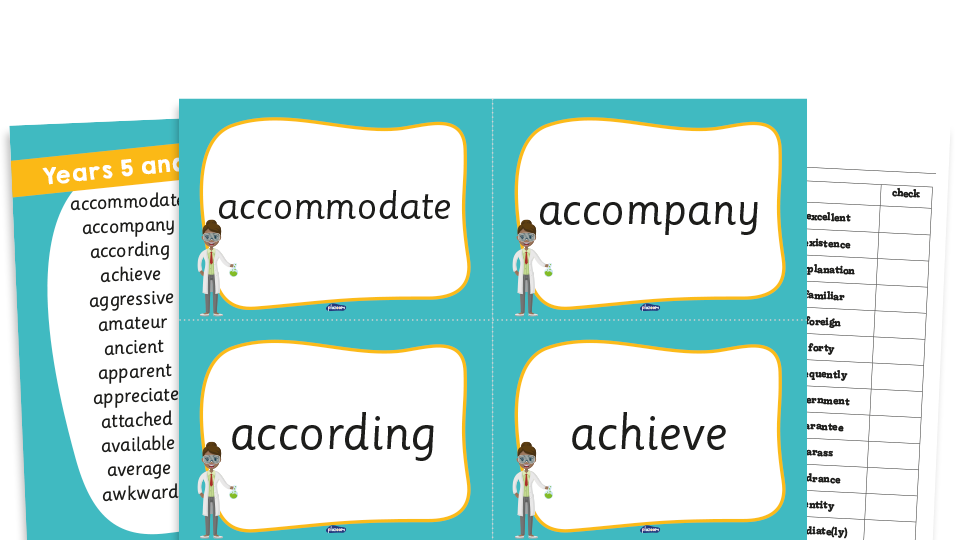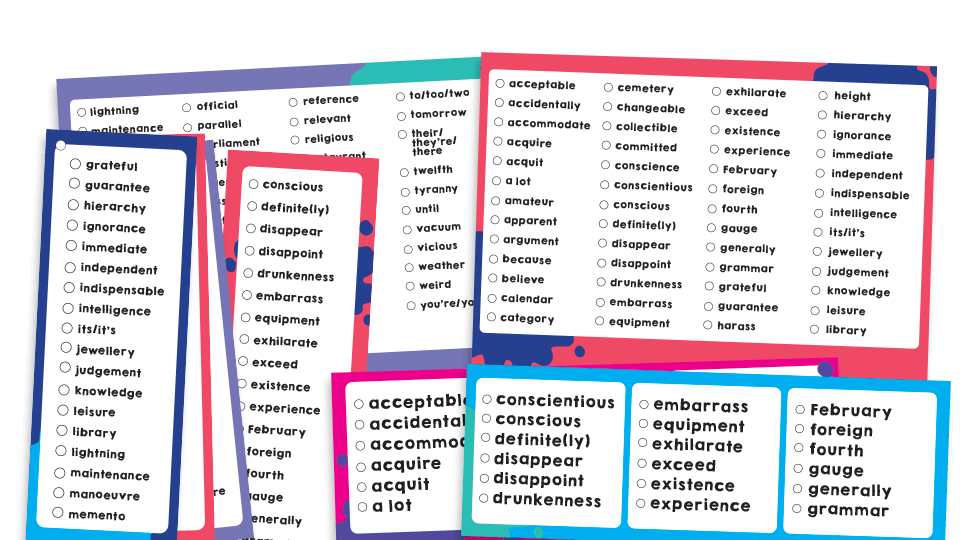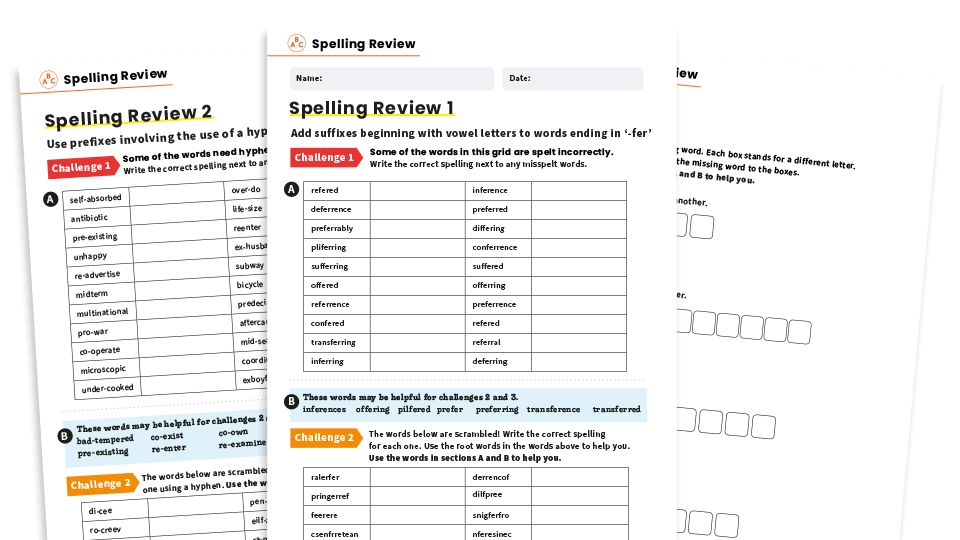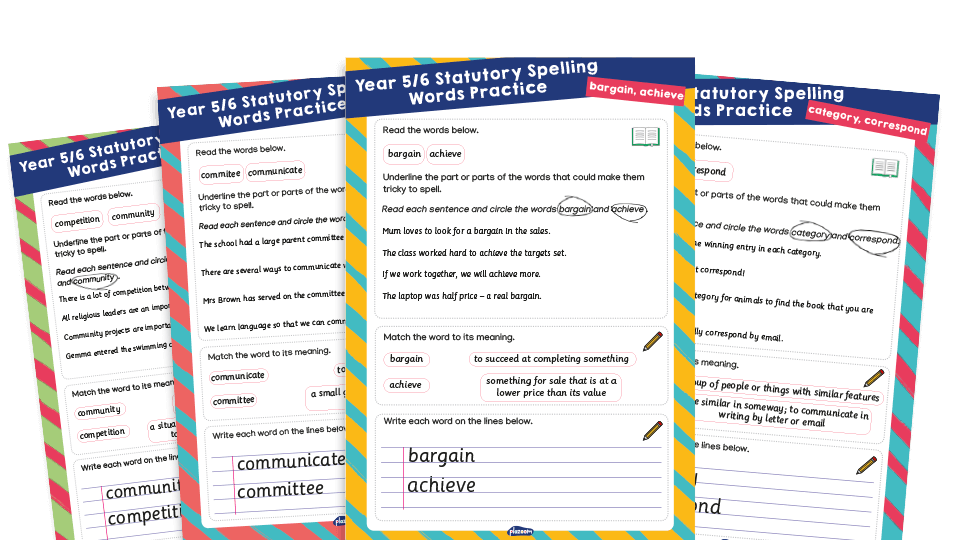Spelling resources – Advice and classroom printables for KS2
It’s no exaggeration to say that if you want to equip your pupils for a future of achievement without embarrassment, you must appreciate the need to accommodate sufficient spelling practice into your congested teaching programme.
You also need an intimate knowledge of the words you are supposed to be teaching. For example, how many words from the list of Year 5-6 statutory spellings can you spot in that first sentence? What other spelling patterns can you identify?
SATs and spelling skills
Of course, good spelling is an important skill that could play a key role in improving your pupils’ life chances. As the end of Key Stage 2 approaches, however, that more distant ambition is superseded by the looming SATs.
Here are some tips, pointers and spelling resources to help you make sure your pupils do themselves justice when the pressure’s on...
Statutory spelling word list
You know this already, but sometimes it doesn’t hurt to be reminded: they are called statutory for a reason. You are legally obliged to teach them.
That doesn’t mean your pupils will be carted off to prison should they spell them incorrectly. However, it does emphasise the importance with which they are viewed.
The Year 6 spelling list, which applies to Year 5 pupils as well, comprises 100 words that are considered to be frequently used or commonly misspelled.
Quite how useful the words hindrance or secretary would be to a modern school pupil is unclear, but ours not to reason why.
The point is that they should be taught, which means they could be tested. Use our statutory spelling resource pack to keep them at the forefront of your pupils’ minds. It includes cards for display and mats for the table.

Don’t forget common spelling patterns
Obviously, it is not enough to be able to spell just 100 words accurately. By the end of Key Stage 2, pupils should be able to apply all of the spelling strategies and rules outlined in Appendix 1 of the National Curriculum for English. It's sometimes easy to forget that.
Do make time to revise Year 3-4 spelling rules and statutory words as the big SATs showdown approaches. Help is at hand, however, as we offer a comprehensive set of Spelling Workouts at the top of this page.
These spelling resources will help pupils revise statutory words and apply spelling patterns from Year 1 to Year 6.
Spelling pattern resources
One of the best ways to embed correct Year 6 spellings is to make sure they are applied in practice. After all, these are supposed to be common words, so they should be occurring in pupils’ everyday writing.
In the same way that we use stabilisers for children who are just learning to ride bikes, it doesn’t hurt to have spelling supports readily available on the understanding that, eventually, they will no longer be needed.
Our Year 6 difficult spellings toolkit, with its bookmarks, table prompts and word fans could provide the confidence boosters they need.

Spelling concepts – prefixes, suffixes and root words
Anything is easier to learn when it makes sense. Having some insight into the etymology of words can be more useful than you might imagine.
Ask your class to make ‘trees’ of connected words, all branching out from the same root. For example, how many words could they make from the root port meaning to move or carry? There's porter, import, export, support, transport, transporting, transportation (that’s for starters).
Just looking at that list also shows the importance of understanding suffixes and prefixes. For example, how do ex-, im-, trans-, -er, -ing and -ation affect the root word?
Our revision challenge sheets take an in-depth look at the suffix -fer. Incidentally, they are also great for practising homophones and hyphens.

Practising with spelling revision resources
Even though there is plenty of merit to the old ‘look, cover, write, check’ approach, there is so much more you could do.
If you’re looking for inspiration, a good place to start is our Year 5-6 statutory spelling words packs. There are 12 of them in total, covering all 100 words on the list.

They challenge pupils to locate the words in sentences, identify their meanings and even copy them neatly as handwriting practice.
Spelling word search games
Knowledge is more likely to be retained if the learning process is enjoyable. We have a range of resources to make spelling more fun.
Take our word searches revision pack, for example. Not only do pupils have to find the words (without a prompt for those who like a greater challenge), but they also have to identify the spelling pattern.

An accompanying worksheet features activities to help pupils explore the spelling patterns and vocabulary further, and in different contexts.
Spelling practice tests
Of course, one of the unavoidable realities of learning to spell is assessment, not least the spelling element of the Grammar, Punctuation and Spelling SATs.
There is mixed evidence as to whether spelling tests are an effective way of teaching children to spell. However, it will help pupils to do justice to themselves if they are familiar with the format of the SATs spelling tests. So, do find the time to let your class practise these before the big day.
We hope this has given you some ideas for enhancing your already excellent professional practice and offered the opportunity to sacrifice or interrupt less of your leisure time. Perhaps you could use that time to enjoy a journey in a vehicle or even a yacht, if you have one.
If that awkward, even desperate, wording suggests to you that there are more statutory words to identify in the above paragraph, you’d be right...
Sue Drury qualified as a primary teacher in 1999. Teaching pupils from Year 1 to Year 8, she has held a variety of positions including maths and English subject leader, year leader, and assistant headteacher. Sue has mentored students and NQTs, offering guidance and advice using her years of experience. She created many of Plazoom's literacy resources.